Text
Final Video Presentation - Unexpected Japan
youtube
1 note
·
View note
Text
Independent Excursion: Academic Reflection
I chose to go to Sanja Matsuri as an independent excursion, a festival held annually at Sensoji in Asakusa. The festival celebrates the founders of Sensoji and brings over two million people to Asakusa throughout the three-day festival, making it one of the most popular festivals, according to the Japan Guide. [1]
I started my excursion by meeting up with my friend Tomas from my study abroad program last year. Being in the Tokyo Area, it was a great opportunity to meet. We went to UNIQLO first to get some hats since it was sunny. They were pretty comfortable, but they had a weird logo on them.

Once we had got our hats and put on some sunscreen, we went to the festival. We got to the temple early, and when we arrived it was already a bit busy. In the distance, we could see people carrying mikoshi and decided to get a closer look. Mikoshi are vehicles that transport deities from one temple to another. In other words, mikoshi are portable shrines carried between permanent or temporary shrines by people. Since we arrived there early, we saw the parishioners carrying mikoshi close up. As a result, I was able to take some incredible photos.



Men and women of all ages could be seen carrying the mikoshi. We even saw young children carrying smaller mikoshi. A common chant that could be heard as they carried the mikoshi toward us was wasshoi. While chanting, they would also toss or bob the mikoshi up and down. It was really cute to see young children carry the mikoshi and chant wasshoi.

The parishioners also wore special outfits as they carried their mikoshi. I imagine this was to represent which shrine they were representing. Before the festival, I saw a group of men dressed in these outfits drinking outside a Family Mart, which I found amusing. I would probably also want to grab a drink before carrying a mikoshi on such a hot day.
By the time we finished watching the mikoshi, it had become crowded, and we were thirsty and hungry. We left the temple grounds and entered the area filled with yatai, stands that sell food and drinks. I decided to get a homemade carbonated lemonade float which not only satisfied my thirst but also my hunger. As a staple of Japanese festivals, I highly recommend going to food stalls.

Academic Reflection
To further examine Sanja Matsuri, I read Script and Score: Revisiting Nelson Goodman at Sanja Matsuri - Japan by Ray Lucas. This chapter of Architecture, Festival and the City focuses on the anthropological and architectural aspects of Sanja Matsuri and explains the festival's traditions.
One point of discussion I found interesting in the reading is the "collapse of various strata of social and spiritual life into the space of the city" in festival culture. Lucas points out how while the Tengu walks around: city authorities, priests, and geisha can be seen alongside fishermen and carpenters. [2] I haven't thoroughly considered the diversity and complexity of Japanese festival culture until reading Lucas' work. Reflecting on my experience at the festival, even the parishioners carrying the mikoshi were of all different ages and backgrounds. I began to wonder how long this history of festival diversity extends.
Lucas uses a variety of methodologies to further examine these aforementioned aspects, including photography, drawing and painting, and mapping. I found the observations of the matsuri uniforms interesting as I had little prior knowledge of the subject area. The reading outlines how drawings depicting the outfits have "stiff seams of fabric and wide sleeves." [2] However, the reading scrutinizes some of the poses seen in these drawings and offers some explanations as to the reasons why these may be inaccurate. Another imperative aspect that Lucas considers in his study of Sanja Matsuri is the consideration of the limitations of each of these three methodologies. Unfortunately, the analysis of each of these methodologies is not very useful for the scope of this discussion and difficult to understand from my background. However, I still found that the reading provided an interesting explanation of the background of the festival.
[1] “Sanja Matsuri.” (Sanja Festival) - Tokyo Travel. Accessed June 1, 2024. https://www.japan-guide.com/e/e3063.html.
[2] Lucas, Ray. “Script and Score Revisiting Nelson Goodman at Sanja Matsuri – Japan .” Essay. In Architecture, Festival and the City, 81–96. London, United Kingdom: Routledge, 2019.
0 notes
Text
Independent Excursion: Media Reflection
I chose The Tatami Galaxy, written by Tomihiko Morimi, as my media representation of Japan. The anime, adapted from the novel of the same name, is centered around Kyoto University. However, many other notable locations in Kyoto are also featured. I decided to go to some of these locations.
The first location I visited was the Shimogamo Shrine. This shrine is featured at the beginning of the first episode for its hidden ramen cart nearby, Cat Ramen. Unfortunately, the existence of this ramen cart is fiction. However, I still thought it would be fun to visit the shrine. The surrounding area of the shrine was beautiful, with thick woods arching over paved walkways.


Next, I visited Demachiyanagi Station. Being close to where the protagonist lives, the station is explicitly mentioned in the anime. While there wasn't much to see there, I ate some ramen in honor of Cat Ramen. I got the lunch set for only 1,000 yen and as you can see in the photo below, it was enormous. I highly recommend Kamomachi Ramen in Kyoto if you're in town.

After finishing eating, I embarked on the Kyoto University Clock Tower. Being a vital part of the anime's plot, it was a unique experience seeing it in person. I will elaborate further in the reflection portion, but I found it an incredible experience to see a scene from a piece of media in real life.
Finally, I ended the day with the most significant location, the Kamogawa Delta, featured in one of the anime's most memorable scenes. As Master Higuchi plays his iconic song here, the night sky is lit up in awe-inspiring fashion. Seeing this location in person made me feel a new connection to it. As one of the anime's most emotional scenes, it gave the location a weird nostalgic feeling.


Reflection
The Tatami Galaxy is a coming-of-age story of a student trying to find the perfect college life. The main protagonist is unnamed, with the name "me" in English. Every time that Watashi has doubts about his college life, he is transported into a world where he is in a different "circle." Circles are social-oriented clubs in Japanese schools, similar to many American clubs. Each time he begins a different life, the Kyoto University Clock Tower begins winding.
The Kyoto University Clock Tower looked very similar to the anime. However, I couldn't help but feel there was a difference between the anime and the real-life campus. It may be due to when I went, but it seemed much quieter. Perhaps to emphasize Watashi's perceived importance of campus life, the anime uses a variety of different colors and camera shots to make it seem more active than reality. However, this might be because of the time I went or that I wasn't allowed to explore the campus.
Another main character to mention is Master Higuchi, an eighth-year senior who lives in the same dorm as Watashi, the protagonist. Higuchi is always seen wearing a yukata and claims to be a god, passing on "wisdom" to his disciple Watashi. While his claims of being a god are seemingly absurd, his personality is beloved by many. Furthermore, the author often purposefully makes it unclear whether or not his claim of being a god is true. Who else would allow Watashi to transport to parallel universes?
One of the anime's most infamous scenes is Higuchi playing a song on the Kamogawa Delta, where the Takano and Kamo Rivers meet. Traveling to this site, there was some slippage between reality and the anime depiction. Firstly, in the anime, Higuchi is the only one in the Kamogawa Delta, making it seem like a majestic place fitting of Higuchi's mysterious character. However, traveling to this site, it becomes immediately apparent that it is a heavily traveled tourist destination. I even asked someone to take my picture there in Japanese, and they turned out to be Chinese!
Higuchi's song lyrics are seemingly nonsensical on first listen, talking about a triangle, a circle, and a square. However, they perfectly represent human's desire to be perfect. Throughout the anime, Watashi is so focused on achieving the perfect campus life that he forgets about the opportunity "dangling right in front of him," repeatedly foreshadowed by the fortune teller. When he finally forgets about his perfect campus life, he notices what he must do: ask out his crush.
Higuchi's song perfectly suits Kyoto's natural beauty. The Kamogawa Delta was a place where I could be mindful of the world around me. Sitting on the same rocks as Higuchi, I was reminded that it is sometimes important to forget about the ends of our ambitions and focus on what is in front of us now.
0 notes
Text
May 30 - Kawaramachi
Yesterday was my last required blog post. From now on, blog posts are optional and will lack an academic reflection portion. I also expect that the quality of the writing may be worse as a result.
I got to sleep in today! I left the hotel around 11 AM and met up with my girlfriend and some of my friends. We walked around downtown Kyoto. We started the day by getting macarons, candy strawberries, and juu en pan, a waffle-like bread with a filling of your choice. The macarons were delicious and had cute designs. My favorite was the cotton candy. As for the juu en pan, we got the cheese-filled one. The savory taste of the cheese nicely broke up the sweetness.

When we finished gorging ourselves, we played some gashapon, a machine that gives you a random prize out of a pool of possible prizes. I played a machine that had Undertale characters (a popular video game). I got the best one on the first try (no big deal or anything) and gave it to my girlfriend.

Afterward, we went to the arcade and played a game similar to Guitar Hero, taiko, and my favorite, MaiMai! Even though I have been to the arcade countless times in Japan, it never gets old.

Next, we went to the Kyoto Pokémon Center. We didn't have much time, so we couldn't stay long, but I am sure we will be back soon! Even though we didn't have much time to shop around, we still got to take pictures.

I ended the day with an all-you-can-eat and all-you-can-drink dinner. I got bottomless karaage (fried chicken) and calpis soda sours. The chicken was amazing, and I was completely stuffed by the end.

Today marks the end of the program. I had a great experience and made some incredible friends. The blog posts are no longer required, but the program has inspired me to keep up with them for the remaining two months I am here. Thank you, Professor Smith, for providing the opportunity to travel abroad and learn about Japanese culture. Over the past month, I have learned and experienced so much!
0 notes
Text
May 29 - Nara Day Trip
Nara was today's scheduled excursion. Taking the express train, it took a little over an hour to arrive there. Upon leaving the station, immediately deer could be seen everywhere. A local cart was selling senbei, crackers that could be fed to the deer. I bought a stack of them for 200 yen and began handing them out. Eventually, there was a swarm of deer around me, and I started generously handing out my stack to avoid them biting me. Some of my other classmates got bitten, but not with enough force to leave a bruise or anything. If you bow at the deer they would bow back, which was adorable. Before today, I wasn't much of a deer fan. However, after seeing Nara's deer I have changed my opinion of them. Look at these pictures I took of them!






After playing around with the deer for a while, we went to Kasuga-Taisha, a shrine known for its rows of donated lanterns and thousand-year-old trees. I couldn't help but imagine how pretty the shrine must be at night. Unfortunately, it was still morning, but all hope wasn't lost. We went into a dark room with some of these lanterns, and it almost felt like night. I also got to take some pictures of a tree that is over a thousand years old.


When we finished looking at the lanterns, it was time for lunch. We stopped by a busy restaurant with various different types of burgers ranging from chicken to sukiyaki. I decided to get the Tonkatsu burger and it was pretty good! I also got a side of french fries, but I didn't expect it to be such a large portion.

After lunch we went to Todaiji Temple. Todaiji temple was a truly impressive structure, being one of the largest made of wood. It is so massive, that it almost doesn't feel like a temple from the outside. The inside was even more impressive, boasting a massive statue of the Buddha made in bronze since the 12th century. It is often said that if you are able to climb through the Buddha statue's nostril that good karma in the next life will come. As a result, they have a wall with an opening of the same size that you can try to climb through. I narrowly made it through!


Academic Reflection
Today's reading talked about Vairocana. The reading mentions that Vairocana has three different bodies including a dharma body, an enjoyment body, and a transformation body. It is for this reason that something like a robot can be seen as a Buddha, as Vairocana can take any form with his enjoyment body. Thus, the Mahayana explanation for the historical Buddha was that he was simply one of Vairocana's manifestations. It is for this reason that something as absurd as a robot can be accepted and normalized as a manifestation of Vairocana. When Buddhism first came to Japan this also explained its coexistence with Shintoism, as Shinto gods were said to be manifestations of Vairocana.
Being arguably the most important of the gods in the Buddhist religion, it makes sense why there would be such a large statue of him. I found it especially impressive that it was made of bronze. Unfortunately, the statue is not the same one that was originally built in the Heian Period due to fires.
0 notes
Text
May 28 - Himeji-jo
Today's scheduled excursion was a day trip to Nara. However, many of my classmates wanted to switch today's planned excursion with Himeji Castle. Thus, we went to Himeji Castle instead. Having seen Himeji Castle in popular media depictions of Japan for quite some time, I was excited to see the castle in all of its glory.
The trip to Himeji Castle was a little over two hours each way. Unfortunately, I had to stand the entire way, as there weren't any open seats getting on the train in Kyoto. Despite this, however, I tried to get as much work done as possible. I nearly finished my media reflection that will be posted soon! After what seemed like a pretty long two hours we arrived at Himeji Station.
By the time we got there, it was time for lunch. I wanted to go to one of the nearby restaurants, but unfortunately we didn't have enough time. Instead, we opted for the station food court and I got takoyaki and tamagoyaki, octopus and egg balls respectively. While it wasn't the best lunch I have had while here, it wasn't terrible either.

When lunch was over it was finally time to head to the castle, which was about a twenty minute walk. Unfortunately, the weather today was abysmal. With a constant heavy downpour it made the twenty minute walk seem like an hour, and that was just getting to the castle. When we finally arrived, my shoes, pants, and most of my shirt were already soaked. To make matters worse, I only wore a t-shirt today, since I wasn't aware how much colder the rain would make it feel. I quickly took a picture of the castle and moved onwards so that I could return to the hotel as fast as possible.


On the castle grounds we were able to see Senhime's living quarters. Despite being a princess of the Ieyasu family, she was able to marry her true love. As a result, her story of defiance for love is often adored by many. Inside her quarters lay a statue of her with informational guides as accompaniment.

Upon finishing, it was time to put the puddled-filled shoes back on my feet and head up the mountain! As we went up, I took a photo of a gunhole for muskets.

By the time we reached the top, I was completely drenched and exhausted. However, the journey was unfortunately only half over. The next 3 hours of scaling down the mountain and taking the train back can only be described as torture. By the time we reached Kyoto Station, my teeth were chattering from the cold.


Finally, I got back to the hotel to find my phone would no longer charge, my only shoes soaked, and my stamp books water damaged (since they were in my soaked backpack). While the first two can be fixed, the latter is not replaceable. Needless to say, I think this was my least favorite excursion.
Academic Reflection
Despite what it may sound like, I find the history of castle towns in Japan an interesting topic. Castle towns were responsible for a population explosion in Japan. However, as recently as the 1950s these castle towns were believed to be completely controlled and developed by a despot. Literature since has suggested that these castle towns' development, while facilitated by daimyo, were chonin driven. Aware of this, daimyo kept the needs of the chonin in mind when planning castle towns. They would even relocate farms and temples to build commoner districts.
Going through the castle, more design elements of Japanese castles can be seen. After the battle of Nagashimo, the effectiveness of fortifications designed with guns in mind was clear. Small holes in the castles walls for guns could be seen everywhere as I went up the mountain. Also, note the use of the word mountain. Unlike European castles that were surrounded by thick walls, Japanese castles walls were carved out of mountains. This difference can partly be explained by Japan's excess of mountains.
0 notes
Text
May 27 - Arashiyama Bamboo Forest
We began today's excursion with Arashiyama Bamboo Forest. This popular tourist destination is consistently flooded with tourists. As we walked down the paths with bamboo stretching on either side, I couldn't help but admire the view. While I would've preferred fewer people there, I still enjoyed the experience. Fortunately, while the weather was rainy, it was pleasantly cool.


Midway into our journey through the thick bamboo forest, we stopped at Nonomiya Shrine. Originally constructed as a temporary shrine, this shrine is now a shrine for lovers. I was considering buying a charm, but they were unfortunately very expensive. However, I still found that the shrine had a unique exterior worthy of pictures.

After finishing our expedition through the bamboo forest, we embarked on the coolest part of today's excursion. At the top of a mountain lay an interactive monkey-viewing experience. As we reached the summit, we were swarmed by monkeys. We were informed we shouldn't get within two feet of the monkeys or look them in the eyes. However, the monkeys were very comfortable around humans, and I took a lot of awesome pictures with them. However, viewing them wasn't the only thing we were allowed to do. From the safety of a caged enclosure, we were able to feed the monkeys! As I handed them peanuts I got for only 100 yen, I got to take some more pictures. Seeing monkeys was one of the coolest experiences I have had in Japan.




When we were done looking at the monkeys, it was time for lunch. I went to a local restaurant and got katsudon. I forgot to take a picture before taking a bite again, but it tasted good. While it wasn't the best thing I have had in Japan, it was still definitely worth it.

When the excursion was over, I went to the arcade for a while and played some of my favorite games. Afterward, I got Mos Burger, a large Japanese burger chain. The food was okay, but I prefer McDonalds.
Academic Reflection
Arashiyama Bamboo Forest has been classified as a scenic forest since the Heian Period. However, the forest's protective status has been a persistent issue, regularly changing to protect its incredible nature. However, there have been other issues, including plant-related diseases, monkey and deer overpopulation, and typhoons. The reading discusses the history of Arashiyama as a tourist destination for centuries, with many in earlier times making what was essentially a pilgrimage to the site. Going through the forest and gazing at its beauty, it becomes clear why it needs to be protected.
The other reading was the Sakaki chapter of The Tale of Genji. In the reading, a temporary shrine was constructed for the future priestess of Ise. The girl of Nonomiya, turning out to be Lady Rokujo, a mistress of Genji, attacks Genji's other mistresses. I found this reading to be a bit confusing, though, as Nonomiya became a permanent shrine, now famous for being dedicated to lovers.
0 notes
Text
May 26 - Kiyomizudera
After class, we embarked on Kiyomizudera, a temple famous for its beautiful observation deck and pagoda. Luckily, the weather was nice today, making for some great pictures of the famous pagoda. Our first activity at this incredible temple was the Tainai Meguri. Despite having been to Kiyomizudera once, I had never done this until now. For this activity, you walk through a dark tunnel with only a rope to guide you. It is said you will be reborn when you reach the end of the tunnel. Afterward, we tried to pick up the Spear of Bankei alongside a smaller one. The small one was easy to lift, but the bigger one was impossible! After everyone had failed to lift it, we made our way to the observation deck. The beautiful view from the observation deck is one of my favorite parts of this iconic temple.


When we finished the temple, we were given time to explore the surrounding streets of Sannen-zaka and Ninen-zaka. I got traditional Japanese cuisine called pizza from a local cafe. While it wasn't the New York style I usually prefer, it was still okay. I forgot to take a picture before taking a bite, though.

Shortly after eating, we saw a robot manifestation of Kannon, the goddess of mercy. The robot was a little frightening but novel nonetheless. It moved and talked as it lectured about Buddhist thought, accepting an offering at the end.

After getting some lunch, we proceeded to Gion. The Gion area is known for its Geisha entertainers. Honestly, I don't hate Gion, but I wouldn't say I like it that much either. The attitude towards foreigners tends to be mixed due to bad actors harassing the Geisha. However, we got to see a Geisha perform a traditional dance. Unfortunately, I wasn't allowed to take any pictures but believe me when I say it was a cool experience.

Academic Reflection
The first reading focused on sekkyo-bushi, roughly translating to sermon ballads. One tale told through sekkyo was Shintokumaru. Shintokumaru's mother is killed after insulting the goddess of mercy, Kannon. This part of the story is especially ironic given that she is the goddess of mercy. However, in the end, Shintokumaru is saved by this goddess himself. The story has an emphasis on karma and how bad actions in previous lives can affect your life in the current one. For example, lord Nobuyoshi and his wife cannot have kids because they both destroyed bird eggs in a previous life. It moved and talked as it lectured about Buddhist thought, accepting an offering at the end.
The reading contextualizes the type of god that Kannon is. For example, at Kiyomizudera, a temple dedicated to Kannon, you can choose to drink from one of three streams. Each of these streams is said to grant good fortune in one aspect of life. However, if you try to drink from multiple streams, you receive nothing. Furthermore, the idea of Kannon being able to manifest itself in many different forms is put to its extreme with its manifestation in a robot, as mentioned earlier.
The reading about Geisha is also informative. As someone raised in the West, Geisha are often depicted as simply high-class prostitutes. However, the reading outlines how they were masters of many arts and great intellectuals. Also, as time went on, Geisha moved away from the sex industry. The start of this phenomenon can be traced back to the Meiji Restoration, as monogamous devotion became the more socially accepted practice, however, prostitution remained for many years. Today, the vast majority of Geisha are not sex workers at all and work to preserve many traditional art forms.
1 note
·
View note
Text
May 25 - Day Trip to Osaka
We had our first excursion to Osaka! First, we visited the Umeda Sky Building. This building was the third observatory that we have visited in the program. Unlike the other two times, this observatory was outside. I preferred this to the indoor views of the other two as it also made for much better pictures.
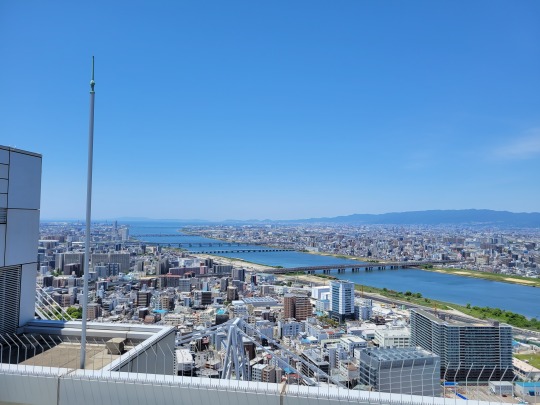
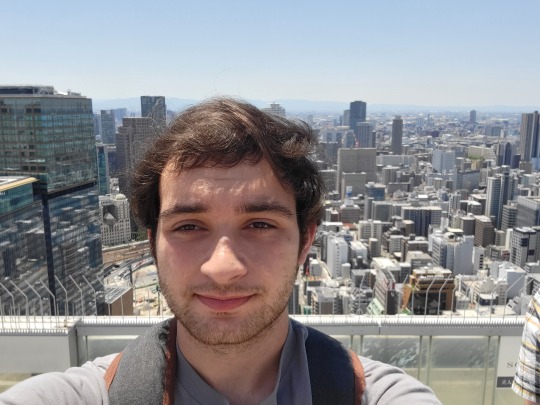
From the top of the observatory, you could see the infamous Gate Tower Building, known for having a highway that passes through the building! I will elaborate more during the academic reflection, but it was impressive to see it in person.
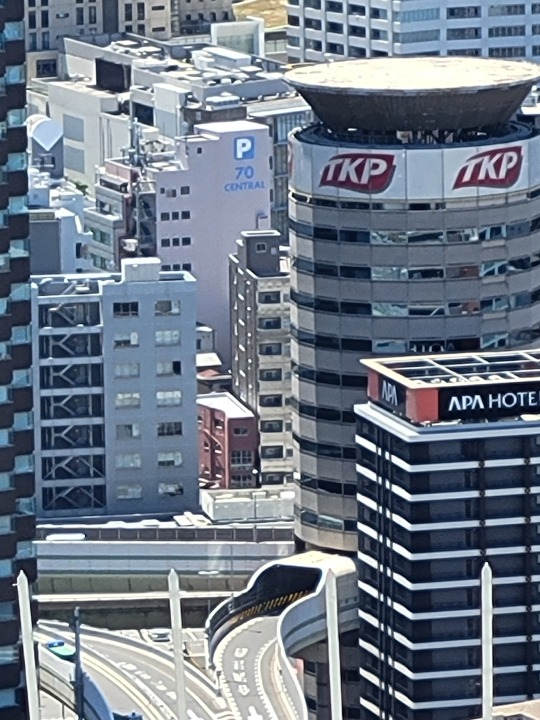
When we finished looking down at the city, it was time for lunch. Luckily, the Umeda Sky Building has a plethora of food choices. I decided to get chicken katsu with a cheese curry at CoCo Ichibanya, a chain curry restaurant. It was delicious, but I'll let the photo speak for itself.

Afterward, we embarked on Osaka Castle. While I have been once before, its exterior beauty is still impressive. Unfortunately, after remodeling the interior, it no longer feels as authentic.

Our last scheduled destination was Dotonbori. Dotonbori is sprawling with entertainment, restaurants, and small bars. Alongside the canal, you can find the infamous Glico Man, a billboard that has existed in some capacity for over half a century!

After being released from the scheduled excursion, I visited the Osaka Pokémon Center and Ghibli Store. I didn't buy anything because I wanted to save money, but it was fun browsing. I thought that the Ghibli store had some especially cute merchandise.

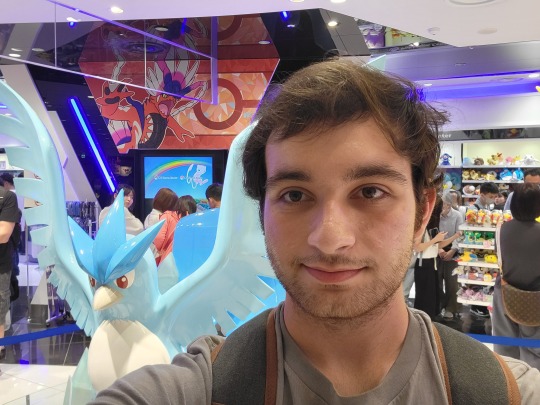


Academic Reflection
Focusing primarily on Japanese architectural differences from Western nations, I found that the content of the assigned reading was interesting. Simply flying over a Japanese city outlines many of its differences from Western cities. Previous readings have discussed how Japanese zoning restrictions are far less restrictive than their European counterparts. However, Perez adds some additional noteworthy points.
Osaka began heavy industrialization as early as the late 19th century, with the opening of the Tokaido Main Line shinkansen from Tokyo to Kobe. However, with this rapid industrialization came many problems such as housing shortages and poor living conditions, earning it the name "city of smoke." Plans drafted to alleviate these problems included the statement of a land readjustment policy. Land readjustment is similar to emanate domain in the United States, and it forces land owners to comply with public building projects. While many landowners will simply sell their land, those who know their rights may negotiate better agreements. Such is the case of the infamous Gate Tower Building, which has a highway running through the building. Rather than sell the property, the landowner removed floors 5 through 7 and offered to rent them to the local municipality!
1 note
·
View note
Text
May 24 - Kinkakuji
I woke up early today and got the new bento before class. After class, we embarked on Kinkakuji, a gold-covered temple. While I have been there once before, I still found it interesting. We walked around the temple, taking pictures of its unusual appearance. Unfortunately, Kinkakuji is a popular tourist destination. As a result, the flood of domestic and foreign tourists made it difficult to appreciate the temple. Despite this, I still made the most of the experience and tried to enjoy it as best I could.

Afterward, we visited Daitokuji, a Zen temple founded in 1319. Known for its karesanui and the burial site of Sen no Rikyu, a famous tea master, the temple has a rich cultural history. However, unlike Kinkakuji, it is far less visited by tourists. As a temple made for reflection and meditation, it was mostly silent. This silence made the perfect atmosphere for appreciating the karesanui. My favorite karesanui recreates a ripple effect of a rock dropped in water. I can not recommend Daitokuji enough to those who want to immerse themselves in a Buddhist temple, away from the flood of people in other Kyoto sites.


The planned excursion ended with the two temples. I was tired and hungry, so I figured it was time to get some food. We stumbled across a burger joint called The Hamburger, known for its large American-style burgers. I got the double Oklahoma Onion burger with fries and a Coke. The meal was a nice change of pace after having mainly different Japanese food over the past two and a half weeks.

Since we got back early, I took a nap. Since getting to Japan, I haven't had the opportunity to sleep much and it's taken its toll on me. I also did some laundry and caught up on some work.
Academic Reflection
Even though I have been to Kinkakuji once before, with my new knowledge from the reading, it was a different experience. Kinkakuji was first built in the late 14th century and survived for hundreds of years. However, I learned that as recently as 1950, the temple was incinerated by an arsonist. For this reason, when visiting the temple today, the gold outer layer still shines brightly in the sun. His reasons for doing so are still unknown, but The Golden Pavilion speculates that it was because its beauty was distracting him from other pleasures in his life. Even though I found this psychoanalysis to be a bit of a reach, I think it was fun to entertain the idea.
Another reading also discusses Zen gardens. Before this reading, I had no idea that Zen gardens was a Western term incorrectly describing karesanui, which was not exclusive to temples. Karesanui is used to symbolically represent Buddhist lands thought of during meditation. After seeing examples of karesanui in person, I realized that they can create an environment that helps someone reflect on themselves in peace.
2 notes
·
View notes
Text
May 23 - Free Day
I returned to Tokyo! I spent time in Tokyo with my girlfriend and two of my friends. We woke up at 9:00 AM and left an hour or so later. Our first destination was the Imperial Palace. It was strange returning to a tourist destination I so recently visited. This time, acting as the group's tour guide, I explained many of the palace's features. Teaching my friends about the palace gave me a newfound appreciation for the reading materials and our excursion. After getting a stamp at the gift shop, we visited the garden. Even though I have visited the garden before, it still does not cease to amaze me. Sharing the pretty flowers, peaceful koi, and small waterfall with my girlfriend was an unforgettable experience.

After gazing at the garden's beauty, we visited the Nihombashi Pokémon Center. While I am someone who likes Pokémon, my girlfriend has me beat. I avoided making purchases to save money, but my girlfriend got three plushies. In addition, my other two friends also got plenty of plushies and figures! Seeing my friends react to a Pokémon Center was a heartwarming experience.


With bags full of plushies and other Pokémon merchandise, we embarked on Akihabara! Our first stop was Melonbooks, a store known for its extensive doujinshi collection. Doujinshi are self-published works that have proliferated Japanese otaku culture. If you want to read more about my experience with it, I recommend reading the Akihabara post! Next, we went to animate. Animate is a store that specializes in various character goods and manga. For those who like manga and anime, this store is a must-visit. While my friends finished looking around in animate, my girlfriend and I went to the arcade. It was a blast playing a plethora of different arcade games!

After the arcade, I showed my friends Donquihote, a store selling everything from everyday products to luggage. I bought a variety of Japanese snacks for my girlfriend to try. For dinner, we went to the most Japanese restaurant around, Denny's. But seriously, I didn't have much time to catch my bullet train home, so I decided we should get something nearby. Japanese Denny's is nothing like those of the United States. Staples of Japanese twist on the American franchise include hamburg steaks, pasta, and a drink bar. I got hamburg steaks, rice, and, of course, calpis soda.

I barely made my shinkansen back home, but I had so much fun. I cannot wait for my girlfriend and friends to come to Kyoto for the rest of the summer!
3 notes
·
View notes
Text
May 22 - Kyoto Imperial Palace
I woke up late today, so I didn't have time for breakfast. We began today's scheduled excursion by going to the Kyoto Imperial Palace. I was a little tired and hungry since I missed breakfast, so I wasn't in the best mood. I thought the palace was interesting, but unfortunately, I couldn't hear the guide's explanations well. Between the poor-quality microphone and the sound of people treading on gravel, I couldn't understand him. Luckily, the reading's primary focus was architecture and city planning of this period, so I could still appreciate most of it. However, I enjoyed the garden more than any of the architecture. I thought that the garden was beautiful, and I was able to take some nice pictures in front of it.


Afterward, we voted to determine if we would take a lunch break after the palace. Unfortunately, most people wanted to continue. Thus, the following site we visited was the Kyoto National Museum. Kyoto National Museum is an art museum with artworks and copies of artworks hundreds of years old. For this reason, they do not allow pictures in any of the exhibits. In addition, backpacks were to be held in front of your person, and pens were not allowed. I thought the pen rule was excessive, given that all the artworks were protected in glass, but I did not mind. As for the artworks themselves, they came in many different shapes and forms. Some popular forms included panels and scrolls. I'll elaborate more on an artwork that stood out in the academic reflection.
After about an hour at the museum, it was time for lunch. We didn't know what was in the area, so we looked around and stumbled across Ito-chan, a restaurant specializing in udon, soba, and donburi. I got the nabeyaki udon special for 1,100 yen. While not the best thing I have had in Japan, it was a good meal. Additionally, being a small restaurant, it had an authentic feel that chains cannot replicate.

When I finished lunch, I started preparing for my Tokyo trip! My girlfriend landed here a few days ago, and I am excited to see her. I am currently writing this blog post on the Shinkansen to Tokyo. I still find it incredible that such a fast train is equipped with WIFI good enough to write a blog post.

Academic Reflection
The assigned reading for today primarily focused on the development of Kyoto. The reading explains how the previous capital, Nara, was perceived by many as being old and out of style. Kyoto was the modern replacement of Nara, the former capital of Japan. I found this point especially interesting, considering that Kyoto is now considered by many to be old and traditional. The grid of roads reflects the city's modernity. The naming convention of avenues was a number succeeded by Jo. Confusingly, the areas in between these jo are also called jo. Even today, this system remains and gives anyone traveling in Kyoto a better understanding of the city.
The reading also talks about the Imperial Palace. Notably, I could see some of the gardens, meeting areas, and the famous two trees described in the reading. Of course, since the original has burnt down multiple times, the one I saw today is not the same as the original construction.
Finally, my final point of discussion centers around the artwork I saw at the museum. The Landscape of the Four Seasons, illustrated by Sesshu, is a brilliant art work. It was painted with ink and light color on silk in the 15th century when Sesshu was in China. Sesshu was an incredibly famous artist of his time. I was thoroughly impressed with how many of the museum's artworks were illustrated by him.
0 notes
Text
May 21 - Free Day
Today was our first free day in Kyoto. My excursion today centered around an anime called "The Tatami Galaxy." Written by Tomihiko Morimi, the anime follows a young college student named "Watashi" or "Me" in English. The writer never gives him a name, as most of the story is narrated from his internal dialogue. I will elaborate in my media reflection, but this anime was one of my favorites due to its uniqueness.
The first site that I visited was the Shimogamo Shrine. In the anime's first episode, Watashi makes a pilgrimage to this shrine, not to pray, but to get ramen from his favorite ramen stand behind the shrine, Neko Ramen. However, unlike the anime, I decided to visit the shrine. The surrounding area of the shrine was beautiful and densely wooded with nicely paved walkways. Upon arriving, I purchased a goshuin (red seal stamp) and prayed. I would try to explain the beauty more, but a picture speaks a thousand words.
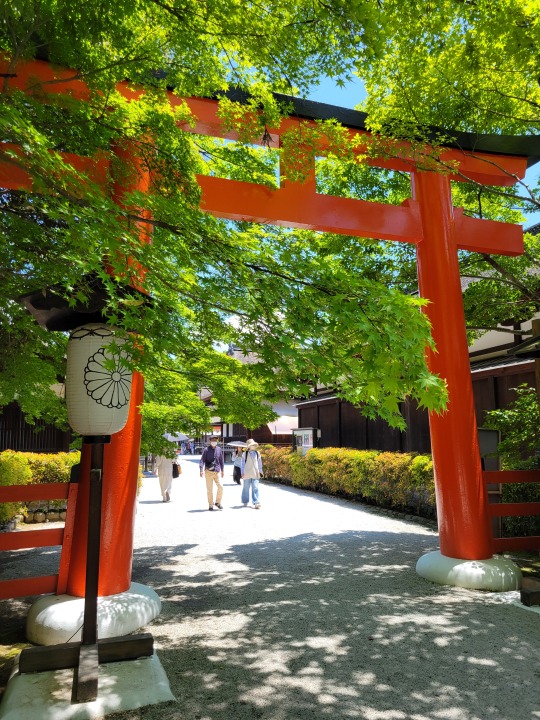

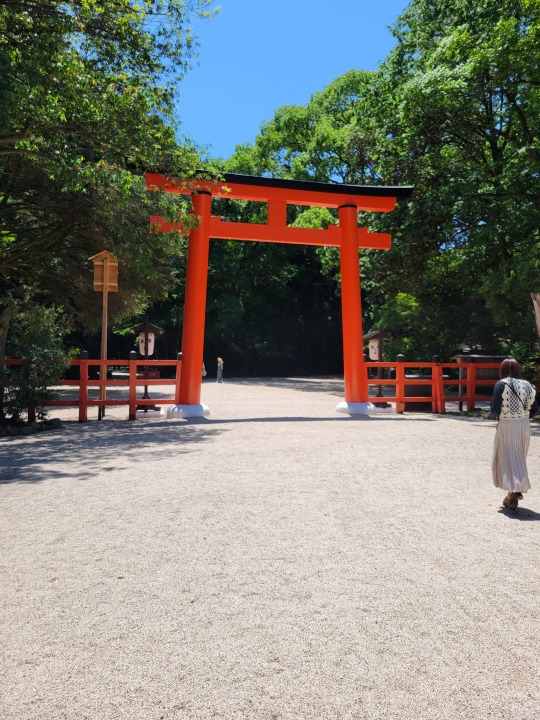
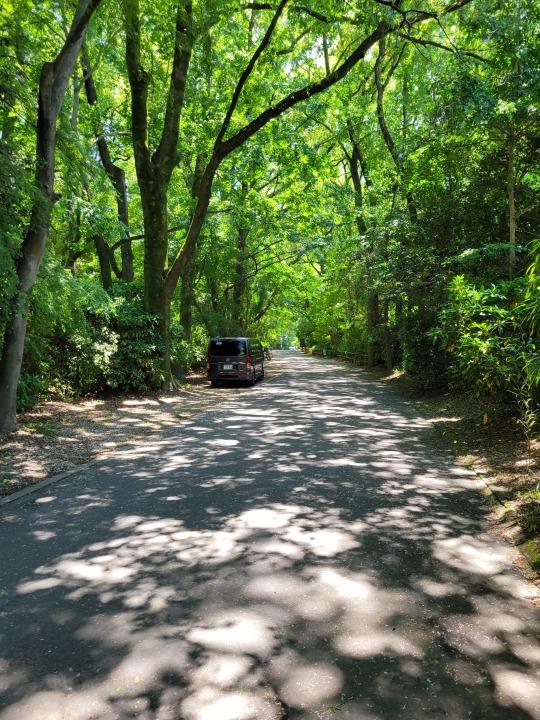
After the shrine, I visited Demachiyanagi Station. This station itself doesn't have much significance. However, I thought it would be interesting since Watashi's 4 and 1/2 tatami flat is behind this station. It was also on the way to other sites I wanted to visit, so it was worth it.

After visiting Demachiyanagi Station, I decided to have ramen nearby to reference Neko Ramen. However, Neko Ramen doesn't exist. In its place, I went to a local ramen shop called Kamomachi Ramen. This ramen shop was tiny, consisting of only a single bar. While English menus were probably available, I could read the Japanese one fine, which gave me some confidence. I ordered the daily lunch set consisting of ramen, rice, karaage shumai, and what was kind of like a spring roll. Despite being such a large portion, it was only 1000 yen! I ate it all and left the restaurant stuffed.
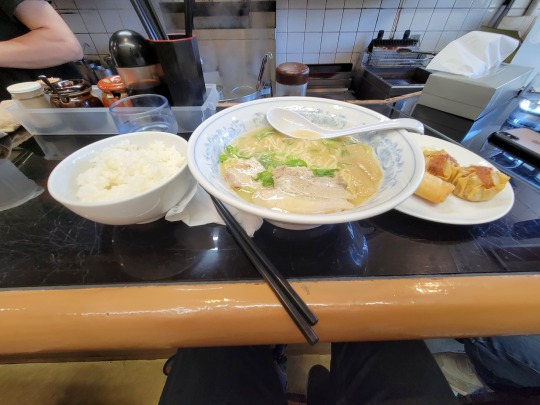
With my stomach full, I set out to the Clock Tower on the Kyoto University Campus, a crucial part of The Tatami Galaxy's story. It was interesting to see in person, but I didn't take a picture since it felt awkward with the campus guards being right in front of me. Afterward, I took a break from my anime pilgrimage and went to the arcade, UNIQLO, Yodobashi Camera, and ED ON. I played my favorite arcade game and bought a nice shirt.


Finally, the time had come for the best part of my excursion. Once again, I will talk about it more in the media reflection, but I visited the Kamogawa Delta. This location is where the Kamo River and the Takano River meet, forming a beautiful triangle. I have attached a picture of the map below if you are still confused. The spot is in an infamous scene of the show, and having been there once before, I recognized it while rewatching it a bit. I went there during the sunset and took some breathtaking pictures. If you are old enough to drink, it would be a great spot to have one while watching the sunset with someone.
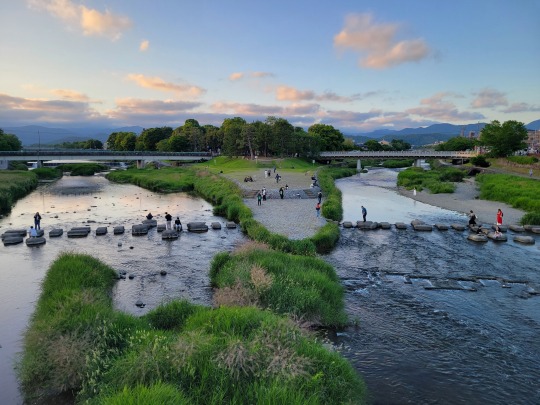


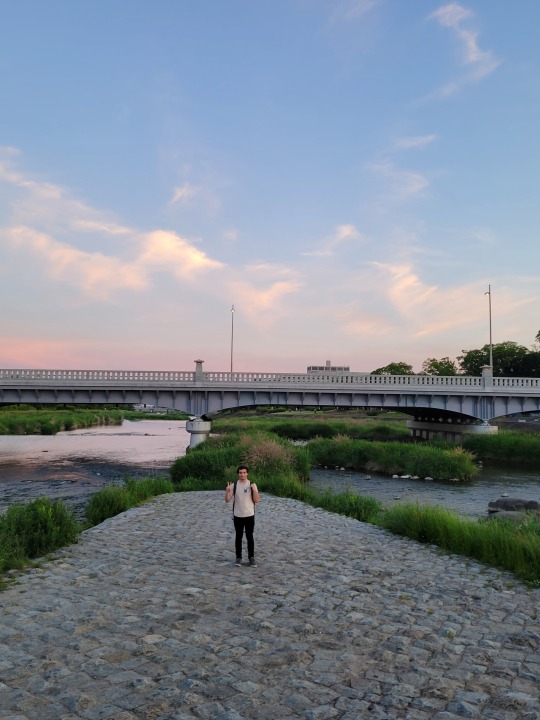
0 notes
Text
May 20 - International Manga Museum
Today was our first full day in Kyoto! Our new hotel doesn't have a meeting space, so we met in a separate building about ten minutes away. After the daily morning meeting, we embarked on our first Kyoto excursion, the International Manga Museum. For those who have any interest in manga, this is a must-visit location. As you walk down the hallways, the walls are covered with manga. In addition, there is a room featuring the history of manga that has manga from the early 1900s to 2000s, a century of manga. In addition, there were several fun exhibits. At one of these exhibits, they had kamishibai, a form of storytelling using paper boards. Despite being primarily aimed towards kids, it can be appreciated by all audiences. The performance was funny, and it wrapped up the museum visit nicely.

Our next excursion was to Fushimi-Inari Shrine. This shrine was unique in that it showed its mirror for the public to view. Unfortunately, pictures were not allowed, so if you want to see it you'll just have to come for yourself! Another unique feature of this shrine was that you could make a wish and pick up a rock. It is said if the rock is heavier than you think your wish won't come true but it if it is lighter it will. Luckily, it was lighter than I thought it would be.

Next, we began to head up the mountain. Climbing up the mountain was pretty tiring but rewarding. The views were amazing, however, not as good as Mt. Takao. Being Fushimi-Inari, I of course got some great pictures though.


Academic Reflection
The assigned reading for today taught me about Inari. I have been to Fushimi-Inari and have seen shrines with foxes before, but I never really knew what they meant. The foxes aren't gods at all but are the messengers of the god Inari, who is said to be a more human-like figure. However, some believe that he is male, while others believe he is female. Being the god of rice, Inari is often associated with prosperity. In Japan, rice has been associated with wealth since feudal times as people exchanged it as a form of currency. For this reason, the reading points out that people of all different backgrounds worship this god.
Entering the shrine, two foxes can be seen at the large tori gate. I found it interesting how there were no depictions of Inari himself. As the reading points out, commonly confuses people into believing he is a fox. As you go up the shrine, more of these fox statues can be seen alongside the impressive tori gates. Many of the foxes were holding things. For example, one of them was holding rice, since Inari is the god of rice.
0 notes
Text
May 19 - Travel to Kyoto
Rather than the usual excursion, today we traveled from Tokyo to Kyoto Station on the Shinkansen. After having our usual class in the morning, we went to Tokyo Station. Having arrived an hour before a scheduled train, we had time to get some snacks. I decided to go to FamilyMart and got melon pan and taiyaki. After waiting a while on the platform, we finally got a glimpse at the train we would be riding.

Once we boarded, I began to eat my snacks. The entire train ride took a little bit over 2 hours. At times, the train moved 180 miles per hour, making the trees and scenery outside the window seem like a blur. However, despite this speed, the riding experience was comfortable and had few bumps. The Shinkansen was less rough than many local trains, which was impressive given how fast we were moving.

Upon arriving at Kyoto Station, we had to wait about an hour and a half to check-in. While waiting, we broke off for lunch. I went to one of the restaurants in the station and got chicken katsu. It was pretty good, but not the best I have had either. Afterward, we took the train to the station nearest the hotel and walked the remaining distance. I was pretty exhausted after checking in.

Academic Reflection
The Shinkansen is a revolutionary technological feat that began development in the 1930s when Japan was still at war with China. During this time, new train lines were constructed with "standard gauge." These tracks were wider than ordinary rails allowing for more powerful trains. As the shinkansen expanded and the bullet train was introduced, the network of standard gauge rails was extended.
Nowadays, the Shinkansen is an extensive network that allows anyone to travel to Japan with relative ease. However, as the reading points out, many often ignore the negative local impacts of the Shinkansen. Typically, bullet shinkansen stations were built in large population centers such as Tokyo and Kyoto. As people can easily visit home with the extension of the Shinkansen network, many find themselves moving to these population centers. This exacerbates the already existing problem of Japan's countryside being abandoned.
As I was riding the Shinkansen, I couldn't help but feel conflicted. On one hand, I was traveling 283 miles from Tokyo to Kyoto in only a little over 2 hours. But on the other hand, as I stared out the window, I couldn't help but think about how many residents of these towns may feel about the Shinkansen. While there are protests against the building of the Shinkansen often for reasons such as the use of eminent domain, I think that general support for the Shinkansen is positive, even among the Japanese population. However, I still believe that it is important to consider both the positive and negative impacts of a public transport system that has been so popularized in Western media.
1 note
·
View note
Text
May 18 - Free Day
There was no planned excursion for today, so I made my excursion instead. I started my day at around 10 AM at Senso-ji for the Sanja Festival, held once annually. I can not understate how impressive this festival was. Being one of Tokyo's largest festivals, thousands of people crowded the streets. Yatai were bustling, and the aroma of sweets blending with savory fried meat filled the air. However, the festival's crowning feature was the Mikoshi or portable shrines. Every year, seventy of these portable shrines are carried to the temple. With gleamingly decorated exteriors, the shrines were visually stunning. In addition, the sound of the chanting fills the air with an excitement that is hard to find elsewhere. I will elaborate on it more in my academic investigation of this festival, but this was a truly incredible experience. When I finished looking at the portable shrines, I purchased a carbonated lemonade float that tasted as delicious as it looked!



Upon leaving the temple, I walked along the Sumida River, enjoying the view. I stopped under the bridge for a while and enjoyed the cool breeze. Then, I began my journey to Skytree to look around the stores for a while. They had Ouran High School and Dead by Daylight pop-up cafes.



When I finished looking around Skytree, I was starving. However, I didn't plan on having any ordinary meal. While taking Japanese at the University of Florida, I saw a film screening titled "Come Back Anytime." This film featured a locally-owned restaurant's impact on its community. It perfectly displayed how food not only fills our stomachs but connects us. The film moved me, and I wanted to try the ramen, so I tried to eat there. Unfortunately, the original restaurant is no longer open as he retired. However, he luckily passed down his knowledge to a few lucky individuals before retiring. These people went on to open ramen restaurants. Hoping to experience the ramen of this documentary, I went to one of these restaurants. I was not disappointed. It was some of the best ramen I have ever had. After walking around the town, enjoying its ramen, and traveling to a local shrine, I felt an even greater connection to the film and its message. For anyone else who enjoyed this film, I highly recommend going!




Finally, I ended the day by playing my favorite rhythm game, Maimai. Today was another incredible day!
1 note
·
View note
Text
May 17 - Odaiba
We began our excursion today by visiting the Fuji Television Museum. While traveling on the train there, the beautiful skyline of Tokyo as well as the infamous Rainbow Bridge could be seen. I will elaborate more about the significance of this bridge in the academic reflection, but it was incredible. This "museum" had a gift shop and an observatory tower that had a pretty amazing view. Unfortunately, I wasn't a fan of any of their shows, so I didn't like the merchandise. Also, while the view was amazing, I had just recently seen the view from Tokyo Skytree's Observatory, making this one seem less impressive. More observant readers may notice that I put "museum" in quotes. This is because at some point they had removed the actual museum. Thus, the beginning of the day was a bit disappointing.

While the museum visit may have been unexciting, the same could not be said about lunch. Today we had an included Japanese BBQ lunch. Situated on the rooftop of one of Odaiba's many tall buildings was an all-you-can-eat buffet of meat with all-you-can-drink soda to wash it down. Not only was it a fun experience grilling our food, but the view from the rooftop was, once again, breathtaking.

Once my stomach felt like it was about to explode, we made our way to a guided tour of Odaiba. We visited the Statue of Liberty (yes you read that right) and a one-to-one scale Gundham. The Statue of Liberty made me feel like I was back in New York, which was strange considering how different Tokyo is as a city. The one-to-one scale Gundham, on the other hand, made me feel like a little kid again. Its scale was like nothing I had ever seen before and I got to take some great pictures of it!


Finally, the last and favorite part of today's excursion was TeamLab Planets. TeamLab Planets is a digital art museum that uses projections, creative lighting, water, and interesting gardens to offer a unique sensory experience. However, those words alone are not enough to describe the feeling of this place. Even the pictures I took will give a bad representation of the exhibits. However, I can not recommend the experience enough to those who are even somewhat interested based on my description.



Academic Reflection
The first reading's main topic of discussion centered around post-industrial leisure centers. In the 1980s, Japan had an economic boom and was at its pinnacle of economic growth. For this reason, architectural projects were often taken with little consideration of failure. During this bubble, office space became an increasingly expensive asset as businesses continued to expand. For this reason, many looked to reclaim the land that was originally used to garrison Edo's coastlines during the 1800's. As this was shown to be ineffective, its purpose shifted to being a series of waste islands. In the 1980s, investors wanted to use this land for more office space, but as the economic bubble collapsed in the 1990s, investors' focus shifted. The idea was to create a large-scale entertainment and leisure area, similar to a theme park.
With this knowledge in mind, many of Odaiba's unique features and attractions can be easily explained. For example, the Statue of Liberty was originally purchased from the French for two years. However, it became such a beloved icon of the city that a replica was created and put in its place. The idea to attract domestic and international tourism explains the Statue of Liberty, giant-scale robots, and the abundance of massive shopping plazas. Even knowing all of this before going, I couldn't help but feel the wonder, similar to Disney, that city planners tried to create.
The other reading discussed Fuji TV as a media conglomeration. Contrary to popular belief, Fuji TV is a massive media conglomeration that doesn't solely rely on films and series. Rather, it relied on TV actors and advertising to diversify its content. The CEO of Fuji TV himself envisioned the company as a digital media factory. The company's success can be attributed to this mindset of production.
1 note
·
View note